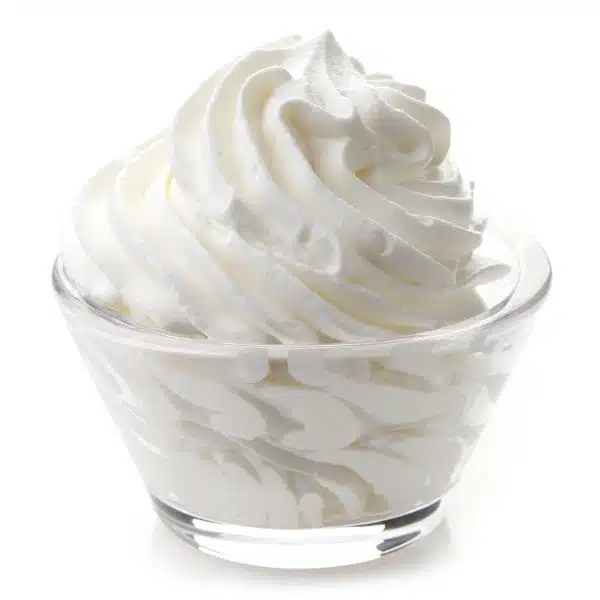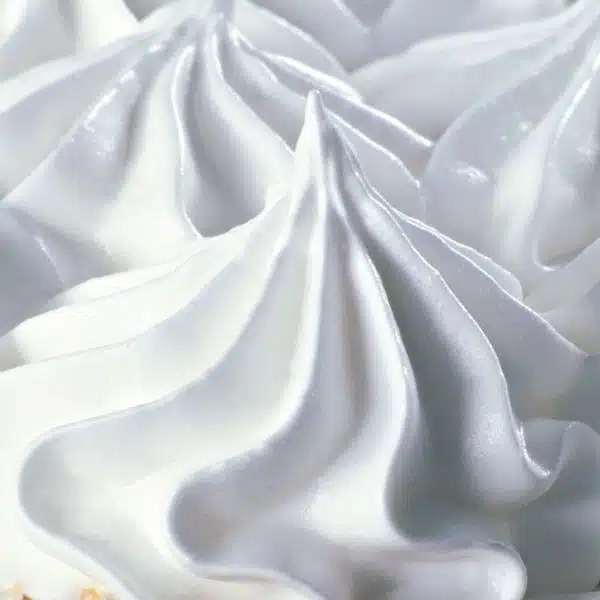Since it comes in an aerosol can and gets eaten up pretty quickly, a lot of folks have no idea how much shelf-life aerosol whipped cream really has – at least besides the expiry date. So, how long does aerosol canned whipped cream last in the fridge, anyway?
It really depends on the brand, but on average, once you’ve sprayed a little whipped cream, you’ve got 2 to 3 weeks that it’s going to taste its best if you store it in the refrigerator. If you haven’t sprayed whipped cream yet, however, it should be good for 2 to 3 weeks beyond the ‘use by’ date – it’s fairly well protected in that can but we wouldn’t recommend pushing before that 2 to 3 weeks.
In this article, we’ll talk a little about what’s inside those aerosol cans of whipped cream, as well as your storage options, and how to tell when that whipped cream is ‘whupped’ and better off in your trash bin.
If you’re ready, then let’s talk about aerosol whipped cream and the secrets to its longevity!
Understanding what’s going on in that aerosol can

Aerosol whipped cream is a pretty neat science trick. The cream inside isn’t whipped yet at all – it’s an ultra-high temperature variety of cream that is treated with stabilizers and highly sugared, sometimes as much as 13%! Stored inside the can with the cream is your aerosol and when you push the button on the can, the pressure makes that aerosol bubble the cream and it escapes with the gas.
Voila, you have instant whipped cream!
While it’s hard to beat the safety of a gas-filled can, we should note that you shouldn’t be licking the nozzle and should, in fact, wipe it off after every use. That’s because you can get some bacteria and microorganisms buildup in the areas where all those sugars were released.
Failure to do so can lead to your whipped cream spoiling faster, so if you intend to store it in the fridge for when you’ve got a craving, then be sure to get in the habit of wiping that nozzle. It won’t buy you a lot of extra time, but it can greatly reduce the chances of your cream going prematurely bad.
How can you make aerosol whipped cream last longer?

The downside of that pre-canned, instant-whipped cream is that there is not much you can do to make it last its longest, other than the refrigerator. You can’t freeze it, for instance. If you’ve ever left a Coke in the freezer for too long, then you have a good idea why that is the case.
When you’ve got a liquid inside a pressurized can, the cold can make it swell up inside, and there’s a potential of the can bursting. Mind you, with whipped cream the chances are pretty low.
When the Grainger College of Engineering Physics Van was asked if frozen aerosol whipped cream would explode, they gave an honest ‘we’re not sure’ assessment but also advised that most cans of whipped cream use nitrous oxide as their propellant, and so this gas should not be problematical in the cold.
They ended up recommending that the questioner ‘give it a go’ inside a Ziploc bag, but while there was no feedback to tell us what happened, we CAN say with certainty that a Ziploc will let you freeze remaining aerosol whipped cream if you like – you just have to get it out of that can.
Provided that you spray the cream into a Ziploc, suck out what air you can with a straw, and then seal it and freeze it, your whipped cream could conceivably last an extra 3 months in your freezer, but there is a caveat to this.
Have you noticed how your aerosol whipped cream tends to ‘deflate’ a little if you leave it sitting too long? That happens because it’s not very thoroughly ‘whipped’.
With nitrous oxide as a propellant, bubbles boil up to the surface when you depress the button, and this agitates the sugars, fats, and creams, so you get a quick, gas-powered, and fluffy cream coming out, but it’s quite a bit more short-lived than your standard whipped cream.
So, while you COULD spray it in a Ziploc and freeze it, you’d have a lot better luck with some whipped cream that’s in a bowl, for the simple fact that it’s ‘properly whipped’ rather than ‘chemically quick-whipped’.
Just a little food for thought!
Homemade whipped cream recipe

While we’re on the subject of aerosol whipped cream and its limited storage options, we thought it might be useful to let you know that there is a 5-minute alternative option that will give you fresh whipped cream that you’re going to LOVE.
With just 3 simple ingredients, this recipe from Jamielyn Nie at I Heart Naptime will let you whip up a quick and fluffy whipped cream that’s just about perfect for topping your favorite snacks. Here’s what you’ll need:
Kitchen Tools:
- Mixer with a whisk attachment
Ingredients:
- 1 cup of heavy cream (cold)
- 2-4 tbsp powdered or granulated sugar
- ½ tsp vanilla extract
Steps to make:
- Place your mixer bowl, along with the whisk attachments, inside your freezer for a good 15 minutes to get them chilled and ready.
- In your newly chilled cowl, go ahead and add your 3 ingredients – heavy cream, sugar, and vanilla – and beat them at a low speed until they are thoroughly mixed.
- Beat this mixture on high for approximately 2 minutes to fluff it up and your whipped cream is ready to serve!
How can you tell if aerosol whipped cream has gone bad?

While it rarely lasts long enough to go bad, aerosol whipped cream is certainly not an immortal superfood, so it pays to know what to look for to know when good cream goes bad.
Here are some common signs that it’s time to chunk that aerosol can into the bin:
- Suddenly, sour cream – If your whipped cream tastes sour in the slightest, then it’s time to throw it away. It’s dairy, after all, so just treat it like you would sour milk – by getting rid of it!
- Smelling ‘off’ – Whipped cream doesn’t have much of a scent at all… more of a ‘sweet undertone’, really, so if it suddenly has a noticeable scent that it didn’t have before, whether sweet or sour, then it’s probably a good idea to double-check the date or simply chunk it.
- Dark spots – Dark spots in your normally pristine whipped cream are definitely an enormous red flag, as you’re likely looking at MOLD. You can confirm with a sniff and it should smell earthy but even if it doesn’t, there shouldn’t be discolored chunks inside so eating it is not a good idea.
- Yellowed hue – Your aerosol whipped cream should always look as pure as the driven snow. If it starts looking yellow or even a bit ‘off white’, then it’s best to err on the side of safety and discard the can.
- Watery consistency – If you are just spraying a thin, milky goo that’s not very fluffed at all, then it’s likely that your cream and fats are going bad inside the can and it’s time to replace it.
FAQs
That’s just about all of the time that we have for today, but before we officially ‘check out’, we’ve got a few frequently asked questions to help cover any spots that we might have missed. Let’s take a look!
Does aerosol whipped cream really need to be refrigerated?
Yes, aerosol whipped cream really needs to be refrigerated and it makes good, solid sense when you think about it. The moment you spray some whipped cream out of that nozzle, the contents inside are briefly vulnerable to any microorganisms in the air as there’s a clear (if windy) path to the insides of it.
It’s recommended that you wipe the nozzle after spraying (and don’t lick it – that’s fun but not really so clean), and after you’ve wiped it then put it away in the fridge.
The cooler temperature will help to slow down anything microscopic that might have compromised the can during the spray and you’ll get the longest life out of your aerosol whipped cream.
How should aerosol whipped cream cans be stored?
Aerosol whipped cream cans should be stored upright in a refrigerated space. Storing aerosol cans on their side isn’t recommended, as the gas is more prone to escaping quickly that way and you might end up with a sudden, creamy mess.
How do you keep aerosol whipped cream from melting?
Usually, if you are getting a thin cream, it means that it hasn’t been refrigerated enough. Once you’ve opened it, if you wait to use it again after it’s had a nice, overnight chill, then you’ll usually get the fluffiest results.
If you want to thicken it up a little for a special dessert, you can also cheat a little by mixing in up to a tablespoon of powdered sugar to help as a stabilizer. You’ll get a sweetness boost and the aerosol cream will have a much lower chance of ‘deflating’ or ‘melting’ and making your dessert look less than perfect.
As a little treat, for those of you who love whipped cream, this video from Chao Coffee and Tea will tell you how to make your own fresh whipped cream for use with a whipped cream dispenser, so that you have a fancy way to enjoy your favorite fluffy topping that will also save you a bundle in the process.
Some final words on aerosol whipped cream
In today’s article we have addressed the question ‘how long does aerosol whipped cream last in the fridge?’ and the answer to this is ‘usually 2 to 3 weeks’, although you can certainly defer to the use-by date. Since it’s sealed up in the can, whipped cream enjoys a pretty robust shelf-life for a dessert product, but the caveat is that you really can’t employ any other methods to preserve it.
While you could conceivably freeze it, you would need to spray it out first, as aerosol cans with liquids inside are at risk of exploding inside of a freezer due to liquid expansion. Thankfully, you can whip some fresh whipped cream up in under 5 minutes, though, should you run out of your spray whipped cream and need a quick solution.
We’d like to thank everyone for visiting and we’re looking forward to your comments – there are a lot of interesting tricks and recipe tweaks for whipped cream, and when it comes to amazing feedback you guys and gals never disappoint! Hope to see you again soon!





David learned to cook at an early age after his mother told him that he couldn't live on pizza forever, Dave uses his modest kitchen skills to recreate sorely-missed recipes from home and to occasionally make new favorite ones from places he is visiting.